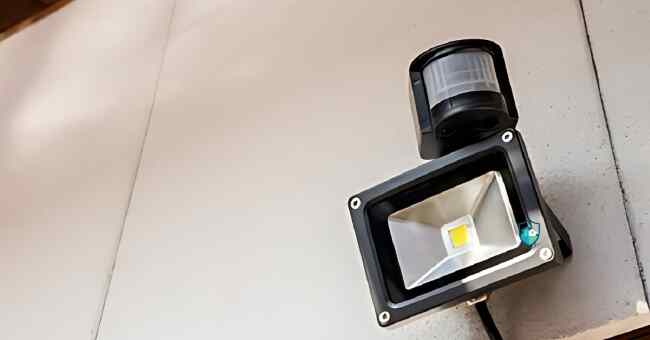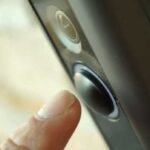Do you wish to know why your motion sensor light won’t turn off and How to fix it? Yes, there are several possible reasons and solutions to consider such as Sensitivity settings, Power surge, Jammed in a mode e.t.c.
It happened right in my home, and it was quite the puzzling experience. We had some renovation work done, and during the process, an old wired motion sensor light was reinstalled in our backyard.
Everything seemed fine until night fell, and the light wouldn’t turn off as it should. It dimmed slightly after the designated time passed, but it stubbornly refused to switch off completely.
Am really confused and wondering what is going on with it. That is how I started do some research to solve the issue.
Now let me tell you how I solve my motion sensor.
Let’s go.
A motion sensor light is a convenient outdoor lighting fixture that turns on automatically when it detects movement.
This type of light offers several benefits compared to traditional porch lights that must be turned on manually.
Motion sensor lights provide added security, energy savings, and convenience.
When something moves within the detection zone, the sensor picks up the motion and triggers the light to turn on.
The light stays lit for a preset amount of time, then shuts off automatically.
This saves electricity since the light is only on when needed. Motion sensor lights are commonly installed on garages, porches, walkways, and driveways to illuminate areas at night when motion is detected.
However, sometimes a motion sensor light continues operating even when no motion is detected.
This is not only annoying, but can waste electricity if the light stays on nonstop. There are several common reasons why a motion sensor light fails to turn off properly.
One possibility is the light’s timer or duration settings are configured incorrectly.
Most motion sensor lights have adjustable settings that control how long the light stays on after being triggered. If set to stay on too long, or in sunset-to-sunrise mode, this could explain why the light won’t go off.
Interference from other light sources, like headlights or street lamps, can also inadvertently keep activating the motion sensor.
Additionally, mechanical defects like a stuck power switch, damaged motion sensor, or worn out bulb can prevent the light from shutting off.
Before replacing the whole fixture, some troubleshooting and DIY repairs are worth trying to get your motion sensor light working properly again.
How To Troubleshooting Motion Sensor Light Not Turning Off
Checking Basic Functions
When troubleshooting a motion sensor light not turning off, the first things to check are the basic functions of the light fixture.
Start with simple solutions before assuming the sensor is broken.
- Check if the light bulb is burned out
- Ensure the power source is active
- Clean the sensor lens
- Adjust the sensor positioning/angle
Check if the light bulb is burned out – With the power off, remove the light bulb and examine it closely. If the filament is broken, the bulb is burned out and needs replacing.
Try installing a new bulb with the same wattage rating. If the light works normally after the bulb change, this simple fix got your motion light working again.
Ensure the power source is active – Check if the circuit breaker or GFCI outlet powering the motion sensor light has tripped. Reset any tripped breakers or GFCI outlets.
For solar powered motion lights, examine the solar cells for dirt/debris blocking sunlight, and confirm batteries are charged. Lack of power can cause unusual operation.
Clean the sensor lens – Dust, dirt, spider webs or insect residue on the motion sensor lens can interfere with detection.
Use a soft cloth or cotton swab dampened with rubbing alcohol to gently clean the sensor lens. Be sure to disconnect power first. Proper cleaning can restore normal function if the lens was obstructed.
Adjust the sensor positioning/angle – If the motion sensor is pointing in the wrong direction or at a bad angle, it may not detect motion well.
Referring to your user manual, re-position the sensor head or adjust the angle as needed.
Pointing the sensor directly at the area you want covered improves the detection zone.
Checking these basic elements first when troubleshooting a motion light that stays on continually can reveal an easy fix.
Burned out bulbs, tripped breakers, dirty lenses, or misaligned sensors are common reasons for apparent failure.
Take time to thoroughly inspect these before assuming electronic components have failed.
Doing simple checks and maintenance routines can often get your motion detector light working properly again without replacement.
Motion Light Doesn’t Turn Off: Sensitivity Settings
The sensitivity settings on a motion sensor light control how easily motion will activate the light.
Adjusting the sensitivity may help resolve issues with the light not turning off.
- How sensitivity controls light activation
- Try adjusting settings to fix over-triggering
- Consider range/distance and ambient light conditions
How sensitivity controls light activation – Motion sensor lights have adjustable sensitivity settings, usually controlled by a dial or switches on the fixture.
Lower sensitivity requires more substantial motion to trigger the light. Higher sensitivity turns the light on with even small movements.
If the sensitivity is set extremely high, even blowing leaves or small insects can activate the sensor continually.
This can cause the light to remain on indefinitely. Reducing the sensitivity may stop minor motions from triggering the light unnecessarily.
Try adjusting settings to fix over-triggering – If your motion sensor light stays on all the time regardless of movement, the sensitivity may be too high.
Refer to the owner’s manual for your particular light to identify the sensitivity controls.
Look for settings like “Low/Medium/High” or numerical adjustments. Start by reducing the sensitivity and check if this resolves the constant lighting.
You may need to experiment with different settings to find the right balance for your particular installation.
Consider range/distance and ambient light conditions – The required sensitivity depends on the range of coverage needed from the motion sensor and the amount of ambient light around the fixture.
For a long-range 40 foot circle of coverage, a higher sensitivity is required. But for a smaller 20 foot range, lower sensitivity may work better.
More ambient light during the day can also activate the sensor, so you may need a lower nighttime setting.
Determining the right sensitivity for your motion light takes trial and error. Don’t rule out adjusting these settings if you find the light staying on persistently.
Getting the balance right for your specific needs and environment can prevent over-triggering while still activating reliably when needed.
With attention to the detection zone, proximity of other light sources, and testing, you can tweak the sensitivity to keep your motion sensor light operating correctly by turning on when motion is detected yet turning off after a preset time.
Faulty Sensor
If adjusting settings doesn’t resolve the issue of your motion sensor light staying on constantly, the cause may be a defective sensor.
Some common signs point to a failed or malfunctioning motion sensor needing replacement.
- Discuss signs of defective motion sensor
- Flickering, turning off randomly, staying on all day
- May need professional replacement of sensor
Discuss signs of defective motion sensor – Unlike bulb or power source issues, a broken motion sensor can exhibit more complex symptoms.
The light may flicker on and off unexpectedly, power up randomly even without motion detection, or run consistently during daylight hours.
Strange and erratic operation is a clue there is a problem with the sensor itself.
You may notice the coverage area is reduced, not detecting motion in zones that worked previously. The light may also turn on very slowly after motion is detected, rather than instantly.
Flickering, turning off randomly, staying on all day – Flickering or flashing when trying to turn on, along with suddenly powering down even when motion is present indicate component failure within the sensor.
If the light works intermittently but cannot sustain operation, the motion sensor circuitry likely has a defect.
When a motion sensing light stays on during the full day, despite having a daylight shut off feature, this points to sensor malfunction.
May need professional replacement of sensor – While some motion sensors are integrated into the fixture, others are removable modular components that electricians can replace independently.
If your troubleshooting has confirmed the issue is with the sensor itself, replacement is likely the necessary repair.
DIY sensor module changes are possible for some fixtures if you are able to obtain the correct replacement part.
However, compatibility issues or lack of modularity may require replacing the whole light assembly.
Consulting a qualified electrician is recommended, since improper sensor installation can lead to other failures.
Though more costly than adjusting settings or replacing bulbs, swapping out a malfunctioning motion sensor is sometimes the only way to get an erratic or permanently lit fixture working properly again.
Pay attention to the specific symptoms to determine if sensor failure is the root cause.
Timer Settings
The timer controls on a motion sensor light dictate how long the light stays on after being activated.
Incorrect timer settings can cause the light to remain on indefinitely.
- Discuss timer settings to control on/off time
- If set incorrectly, light may stay on indefinitely
- Recommend resetting timer according to instructions
Discuss timer settings to control on/off time – Motion sensor lights have adjustable timer controls, sometimes called the “on-time” setting. This sets the duration the light will stay on after motion is detected.
Typical timers range from 10 seconds up to 20 minutes. Shorter times save energy, while longer times provide extended illumination. The settings available vary by model.
Getting the timer set too high can cause the light to stay on long after needed. If a new motion trigger occurs before the timer expires, the on-time starts again perpetually.
If set incorrectly, light may stay on indefinitely – For example, if the timer is set to 20 minutes, that means 20 minutes of inactivity is required for the light to turn off.
If new motion happens every 10 minutes, the timer constantly resets and never counts down to the expiration needed to power the light off. This can make the light stay on indefinitely.
Using an excessively long timer setting, or forgetting to set a timer at all can lead to the light remaining on around the clock.
Always use a timer setting consistent with the traffic in the monitored area.
Recommend resetting timer according to instructions – Referring to your user manual, check the current timer setting and reset it to an appropriate duration.
Most timers are adjustable in increments up to 20 minutes max.
Choose a time that makes sense for how frequent motion occurs in the coverage area, allowing gaps long enough for the timer to expire at night when no motion is expected.
Confirm the light operates as intended by triggering the motion detector and verifying it stays on for the expected time period.
Resetting the light duration prevents lights staying on unnecessarily all day and night.
Damaged Wiring
Faulty wiring connections or chewed/cut wires can also lead to abnormal operation of motion sensor lights, including failure to turn off.
Here:-
- Check connections and wires for damage
- Rodents may chew through wiring triggering constant power
- Consult electrician for diagnosis and repairs
Check connections and wires for damage – Examine where the light fixture connects to power wires. Look for loose, corroded, or improperly joined connections that may intermittently disrupt power.
Wiggling junction box connections while powered on can reveal a faulty contact.
Also inspect the length of wire to the motion sensor head. Fatigued or cramped cords can fracture internally while appearing intact on the outside.
Separations in the wiring can have unusual effects on the sensor functionality.
Rodents may chew through wiring triggering constant power – Nesting mice, squirrels, or even insect damage can cause breaches in the wiring insulation.
The exposed copper conductors can create shorts between the hot and neutral making the light stay energized.
Rodent damage tends to occur higher up in soffits where critters nest. Look for frayed wires with teeth marks or missing insulation.
Electrical tape repairs are only temporary, as chewing will eventually recur.
Consult electrician for diagnosis and repairs – For any significant wiring issues, the best recourse is to call a qualified electrician.
They have the tools and components to properly diagnose connectivity problems and spot Locations where rodents may have accessed the wires.
An electrician can advise whether damaged wiring requires splicing or complete replacement.
Any penetrations into the structure sealing up holes where pests entered will also be part of a proper repair.
Do not attempt DIY fixes on your own for substantial wiring damage or shorts.
Proper diagnosis and correction of wiring issues by a professional electrician can get your motion lighting working reliably again.
Persistent functionality problems that aren’t resolved by simpler troubleshooting likely indicate wiring repairs are needed.
FAQs
How Do You Fix A Motion Sensor Light That Stays On?
The most common reason a motion light stays on constantly is the sensor sensitivity is set too high. Motion sensors have adjustable sensitivity dials or switches to control detection.
Lowering the sensitivity prevents minor motions like branches blowing from activating the light unnecessarily.
Refer to your user manual to locate the sensitivity adjustment and reduce it incrementally until the light starts working normally.
Start at the lowest setting and increase as needed. Proper sensitivity adjustment balances reliable activation when needed without over-triggering.
How Do You Reset A Motion Sensor Light?
If adjusting sensitivity doesn’t fix the issue, try resetting the motion sensor to factory default settings.
Locate the small pinhole button on the sensor labelled “Reset” and press firmly for 1-2 seconds using a paperclip until the light turns off. This clears any improperly configured settings.
Reconfigure the controls starting from the reset default values according to the user manual.
Settings may include sensitivity, light timer duration, daylight sensor disable, and more. Resetting often resolves strange behaviors.
How Do You Turn Off The Sensor On A Sensor Light?
Some motion sensors have a bypass switch that disables the motion detection and makes the light work like a traditional switch. Look for a setting labelled “Bypass” or “Manual Override”.
Toggle this to disable the sensor controls and keep the light off continuously. Use this when performing maintenance to prevent automatic triggering.
Remember to re-enable the sensor when finished. Another option is blocking the sensor lens with electrical tape when sensor operation is not desired.
Why Is My Sensor Light Staying On All The Time?
If your motion light stays on during the day, the cause is likely a failed daylight sensor that detects ambient light.
Quality sensors automatically disable activation in daylight. Cheap sensors lack this feature or have defective daylight sensors.
Covering the daytime sensor with black tape can be a temporary workaround.
Replacement with a better quality motion sensor is recommended for a properly functioning daylight disable mode. Always choose name brand sensors with proven performance.
What Are The 3 Settings On A Sensor Light?
Most motion sensor lights have 3 key adjustments: Sensitivity – Controls motion detection range. Set lower to reduce unwanted triggers.
Duration – How long light stays on after activation. Short times (10-60 secs) save energy.
Range – Detection field size. Wider is 40-50 feet, narrower is 25-30 feet. Play with the combo of these 3 settings to get the best performance for your specific installation.
How Do You Adjust A Motion Sensor Light Switch?
Use the dial, switches or buttons on the sensor to adjust settings. Each model is slightly different. Things to adjust:
- Detection Sensitivity – Turns light on with smaller or larger motions
- Light Timer – Duration light stays on after trigger
- Light Brightness – For dimmable models, adjusts lumen output
- Detection Range – Field of view size – wider vs narrower
Refer to user guide for what controls are present and how to set them. Change one setting at a time to evaluate effects.
What Are The Disadvantages Of Motion Sensor Lights?
Potential drawbacks of motion activated lights include:
- Installation complexity compared to regular light switches
- Frequent light flicker if sensitivity set too high
- Light stays on unexpectedly if sensors dirty/blocked
- No manual control without separate switch
- Higher initial costs than dumb fixtures
- Daylight sensors can fail leaving light on 24/7
Proper installation and settings can mitigate these disadvantages for quality motion detector lights.
Can You Disconnect The Motion Sensor On A Light?
It is possible on some models to disconnect the motion sensor wiring from the light circuitry, effectively converting it to a standard manual light.
However, this requires electrical expertise. An alternative is using the manual bypass switch already included on most sensors to disable motion activation and keep the light off or on continuously as desired.
The manual bypass makes it easy to override the motion sensing features when needed.
How Do You Adjust A Sensor Light?
Follow these tips for adjusting a motion sensor light:
- Clean sensor lens of dirt/debris
- Angle sensor position towards area wanting covered
- Reduce sensitivity setting to prevent over-triggering
- Set light timer duration to shorter time period
- Adjust motion detection field size as needed
- Make small incremental adjustments one by one
Conclusion
Troubleshooting and tweaking a motion sensors settings is usually all that’s needed to resolve constant operation.
Adjust sensitivity first before assuming the sensor is broken. Check for dirty lenses, bad wiring, and improper timer settings too.
With a little trial and error, you’ll get your motion detector light working the way it should to illuminate activity while conserving electricity!





Pingback: How To Replace Adt Motion Sensor Battery: 5 Easy Steps -